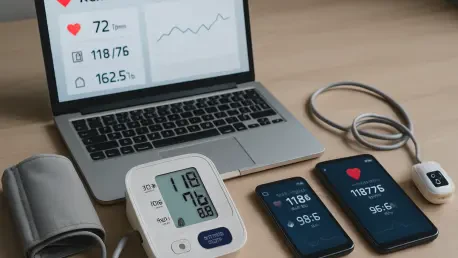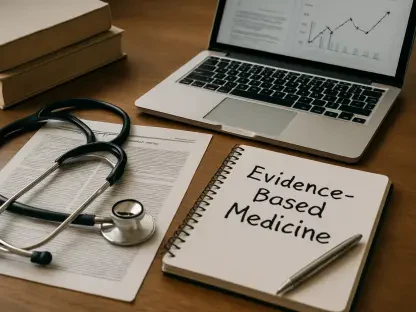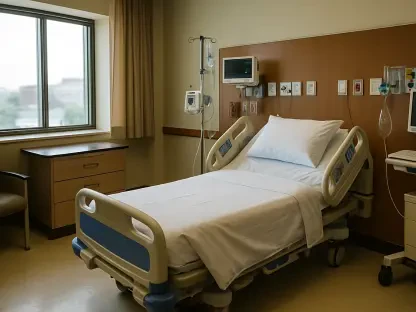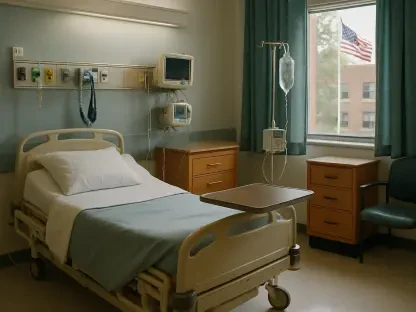In an era where healthcare increasingly relies on technology to bridge gaps in patient care, RDS, a forward-thinking French medical device company, has secured a substantial €14 million ($16.4 million) in Series A funding to drive the expansion of its cutting-edge remote patient monitoring (RPM) wearable, MultiSense. This significant financial milestone not only underscores the growing trust in digital health solutions but also positions RDS at the forefront of a transformative shift in how medical care is delivered across continents. With a focus on enhancing real-time monitoring capabilities, the funds are earmarked for scaling operations in Europe and laying the groundwork for a strategic entry into the US market. This development comes at a critical juncture when the demand for remote care solutions is surging, driven by the need to reduce hospital strain and improve patient outcomes through innovative tools. As the healthcare landscape evolves, RDS’s latest achievement signals a promising step toward a future where technology and medicine are seamlessly integrated.
Accelerating Growth in Europe
The primary thrust of RDS’s newly acquired funding is to bolster the rollout of MultiSense across Europe, a sophisticated wearable patch integrated with a cloud-based platform that meticulously monitors vital signs such as heart rate, respiratory rate, oxygen saturation, and skin temperature. Having earned the coveted European CE mark in March 2024, MultiSense is already operational in 15 hospitals spanning France, Belgium, and Germany, demonstrating early traction in clinical settings. The €14 million injection will be pivotal in ramping up production capacity to meet growing demand, ensuring that more healthcare facilities can adopt this technology. Additionally, the investment is set to support infrastructure enhancements, including refurbishing facilities to streamline manufacturing processes. This strategic allocation of resources reflects a clear intent to solidify RDS’s foothold in the European market, where the appetite for advanced monitoring solutions continues to grow amid evolving patient care needs.
Beyond production, the funding will facilitate significant job creation, with plans to add hundreds of new positions by 2035 as part of RDS’s broader commercialization strategy. These roles will span various functions, from technical development to sales and support, fostering economic growth while enhancing the company’s ability to deliver MultiSense to a wider audience. This expansion is not just about scaling up numbers but also about building a robust ecosystem around the technology to ensure seamless integration into hospital workflows. The focus on job creation also highlights a long-term vision for sustainable growth, positioning RDS as a key player in the European healthcare technology sector. By aligning operational expansion with market needs, the company is poised to address the pressing demand for reliable remote monitoring tools, particularly in regions where healthcare systems are under pressure to optimize resources and improve patient monitoring outside traditional settings.
Targeting the US Market
Shifting focus across the Atlantic, RDS is gearing up for an ambitious entry into the US market, with a targeted launch of MultiSense by 2028. The funding will play a crucial role in initiating clinical trials necessary for securing reimbursement approvals in France and Europe, a critical step before tackling the complex US regulatory landscape. Simultaneously, resources will be directed toward starting the registration process with the US Food and Drug Administration (FDA), a rigorous but essential pathway to accessing one of the largest healthcare markets in the world. This strategic move underscores the company’s recognition of the immense potential in the US, where the adoption of RPM technologies is accelerating as providers seek innovative ways to manage patient care remotely. The planned timeline reflects a deliberate approach to navigating regulatory hurdles while ensuring the technology meets stringent standards.
The US expansion is not merely a geographic leap but a calculated effort to tap into a market where remote monitoring is increasingly seen as a solution to chronic healthcare challenges, such as high readmission rates and overburdened facilities. The funding will support comprehensive studies to validate MultiSense’s efficacy, a prerequisite for gaining trust among American healthcare providers and insurers. This phase of growth also involves building partnerships and infrastructure to facilitate a smooth market entry, ensuring that the technology aligns with local needs and expectations. As RDS prepares for this significant step, the focus remains on adapting to the unique dynamics of the US healthcare system, where reimbursement and integration into existing protocols are key determinants of success. This forward-looking strategy highlights the broader trend of globalizing health tech innovations to address universal care delivery challenges.
Rising Tide of the RPM Sector
The backdrop to RDS’s expansion is a rapidly growing RPM market, which has seen a remarkable upswing, particularly in the wake of the COVID-19 pandemic that necessitated remote care solutions to minimize in-person interactions. According to a 2023 GlobalData report, the market for RPM devices is projected to climb from $550 million in 2020 to $760 million by 2030, reflecting a robust trajectory fueled by technological advancements and shifting healthcare priorities. This growth is driven by the proven ability of RPM systems to enhance patient outcomes, with studies indicating a potential to halve 30-day cardiovascular readmissions—a compelling statistic for healthcare providers under pressure to reduce costs. The surge in demand illustrates a broader shift toward proactive, data-driven care models that prioritize continuous monitoring over episodic interventions.
Moreover, the rise of RPM technologies like MultiSense aligns with the urgent need to alleviate strain on hospital systems, allowing patients to be monitored effectively from home or other non-clinical settings. This capability not only improves access to care for those in remote or underserved areas but also frees up critical resources for acute cases. The market’s expansion is further supported by evolving patient expectations, with individuals increasingly seeking solutions that offer convenience without compromising on quality. As the sector matures, companies like RDS are at the forefront of delivering tools that bridge the gap between traditional healthcare and modern digital solutions. The projected market growth serves as a testament to the transformative potential of RPM, positioning it as a cornerstone of future healthcare delivery systems worldwide, where efficiency and patient-centric approaches are paramount.
Navigating Reimbursement and Adoption Barriers
Despite the optimistic outlook for RPM, significant challenges loom, particularly in the realm of reimbursement policies that have struggled to keep pace with technological innovation. In the US, outdated frameworks often fail to adequately compensate providers for integrating RPM solutions into standard care, creating a financial disincentive for widespread adoption. This lag in policy adaptation poses a substantial barrier, as healthcare systems hesitate to invest in technologies without clear reimbursement pathways. GlobalData analyst David Beauchamp emphasizes that aligning RPM devices with treatment plans and modernizing reimbursement structures are critical steps to unlocking their full potential. Without such progress, even the most advanced tools risk limited impact in markets where financial viability is a key consideration for adoption.
Addressing these systemic hurdles requires a collaborative effort among innovators, policymakers, and healthcare stakeholders to redefine how RPM is valued within care delivery models. The challenge is not merely technical but structural, as it involves reshaping long-standing practices to accommodate new paradigms of patient monitoring. For companies like RDS, navigating this landscape means advocating for policy changes while demonstrating the tangible benefits of their technology through data and real-world outcomes. The focus must also extend to educating providers on the long-term cost savings and improved patient metrics that RPM can deliver, countering initial resistance rooted in financial uncertainty. As the industry grapples with these issues, the resolution of reimbursement challenges will likely determine the speed and scale at which technologies like MultiSense can transform healthcare on a global stage.
Digital Health Trends and Investor Support
The ascent of digital health solutions, accelerated by the pandemic’s push for remote care, has positioned RPM as a pivotal element in modernizing healthcare, offering continuous monitoring capabilities both in clinical environments and at home. This trend reflects a broader movement toward leveraging technology to enhance patient safety and enable timely interventions, reducing the burden on traditional care settings. The appeal of such innovations lies in their ability to deliver real-time data, empowering providers to make informed decisions swiftly. As digital health becomes a cornerstone of medical practice, devices like MultiSense are emblematic of a shift toward more personalized and accessible care, catering to the needs of diverse patient populations across varied settings.
Investor confidence in this space is palpable, as evidenced by the €14 million funding round for RDS, led by Sociétés de Projets Industriels (SPI) and supported by entities such as Critical Path Ventures, MACSF, and Capital Grand Est. This financial backing mirrors similar investments in competitors like VitalConnect, indicating a strong belief in the future of RPM to revolutionize healthcare delivery. Such support not only validates the market’s potential but also fuels competition and innovation, pushing companies to refine their offerings. The influx of capital into the sector suggests that stakeholders see digital health as a sustainable investment, driven by its capacity to address pressing challenges like rising healthcare costs and access disparities. This momentum underscores an industry-wide commitment to harnessing technology for better health outcomes, setting the stage for continued advancements.
Reflecting on a Milestone Achievement
Looking back, RDS’s successful €14 million funding round stood as a defining moment in the journey of advancing remote patient monitoring technologies. The strategic deployment of these funds to expand MultiSense across Europe and prepare for a US launch by 2028 highlighted a bold vision for global impact. Efforts to overcome reimbursement challenges and align with the booming RPM market, projected to reach $760 million by 2030, demonstrated a keen awareness of both opportunities and obstacles. The support from investors like Sociétés de Projets Industriels (SPI) further cemented the belief in digital health’s transformative power. Moving forward, the focus should shift to fostering partnerships with policymakers to streamline reimbursement frameworks, ensuring that innovations reach their full potential. Additionally, sustained investment in real-world studies to showcase RPM’s benefits could drive broader adoption, paving the way for a healthcare future where technology and care are seamlessly intertwined.









